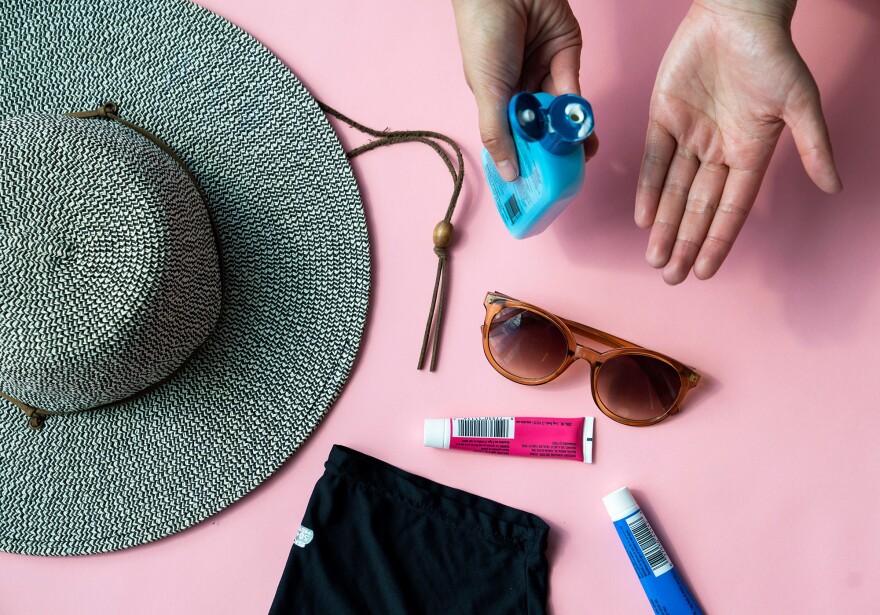Hawaii Gov. David Ige is expected this week to sign the world's first ban on the sale of sunscreens containing the chemicals oxybenzone and octinoxate. The state is banning the products because of concerns they may be harming one of the state's biggest attractions — coral reefs.
While it doesn't kick in until 2021, the move is already prompting pushback.
That's because up to 70 percent of sunscreens on the U.S. market contain oxybenzone, according to the Consumer Healthcare Products Association, which represents sunscreen-makers. Up to 8 percent contain octinoxate, which often shows up on labels as octyl methoxycinnamate.
"We're taking away a product, or products ... that have been shown over the course of time to be safe and effective" against skin cancer and sun damage, says Jay Sirois, director of regulatory affairs for the Consumer Healthcare Products Association.
Indeed, both chemicals have had the Food and Drug Administration's OK for decades, but in recent years, some environmental research has suggested octinoxate can contribute to coral bleaching and that oxybenzone exposure leads to the death of baby coral.
Studies by Craig Downs, a biologist who runs the nonprofit Haereticus Environmental Lab, and his colleagues inspired Hawaii lawmakers to propose the ban to protect the reefs. They point to Downs' 2015 study published in the Archives of Environmental Contamination and Toxicology.
He says the chemical acts as an endocrine disruptor to juvenile coral. "When they come across oxybenzone, they just encase themselves in their own skeleton, effectively killing them," he says. They sink to the bottom of the ocean and die.
Not everyone is convinced by the research so far. Downs primarily observed the coral in a lab, and in the ocean, there are many more factors that contribute to coral death, like pollution and global warming, as Sirois points out.
Oxybenzone pollution can come from other sources, such as wastewater discharge from ships. But sunscreen from beachgoers is a major contributor to pollution in concentrated areas, Downs argues.
"Sunscreen pollution doesn't kill all the world's coral reefs, it threatens coral reefs that are most important to people," Downs says, like those close to shore where tourists like to snorkel. And if there are fewer attractions like beautiful and healthy coral reefs, the tourists are less likely to visit, he says.
Other tourist destinations are considering similar bans to protect their reefs, says Downs. The Caribbean island of Bonaire has already begun to follow suit.
Beverly Hills dermatologist Lisa Chipps is worried that Hawaii's ban is premature and will confuse consumers who have been told to use sunscreen daily.
Loading...
"We know that the cumulative ultraviolet damage that our skin receives every single day damages the cells and predisposes us to skin cancer as well as to all the signs of aging," she says.
The good news is that there are already thousands of sunscreen products that do not contain oyxbenzone or octinoxate, with more working their way onto the market.
In the U.S., there are two basic types of active ingredients in sunscreens: chemical blockers that work with skin to protect against harmful sun rays, and minerals like zinc oxide and titanium dioxide that reflect the rays away from skin. The first category contains some of the chemicals of concern to coral.

If you're worried about the potential impact of your sunscreen routine on sea life, look for mineral sunscreens that don't easily rinse off in the water, suggests Downs. Another choice is to wear swim clothes with sun-blocking fabric, though you should still apply sunscreen to any exposed skin.
Chipps reiterates that it's vital to wear sunscreen. She says the rate of skin cancers detected is going up, despite greater awareness and usage of sunscreens.
The most important things to look for in a sunscreen, she says, is that it protects against both UVA and UVB rays (typically labeled "broad spectrum") and that it has an SPF of at least 30.
As to which brands or formulas work best? It's really a personal preference, says Chipps. "Pick a sunscreen that you like, that you feel good about, that you don't have qualms about, and that makes you happy," she says.
That way, you'll be more likely to use it regularly and reapply often.
Don't forget the best advice for avoiding sun damage — cover up with hats and long sleeves, and avoid going out during the hottest part of the day.
If you are concerned about the possible harms to sea life, be aware that oxybenzone is found not only in sunscreens but also many other consumer products including cosmetics. The Hawaii sunscreen ban applies only to on-island sales of over-the-counter sunscreens. Cosmetics and prescription sunscreens containing these chemicals are exempt.
Hawaii welcomes about 9 million tourists a year. "Obviously we're not going to have the beach police writing tickets" for sunscreen violations, says state Sen. Mike Gabbard, who introduced the bill the governor will sign in the state Senate earlier this year. But he is hopeful that people who visit will think more about the kinds of sunscreen they are using and Hawaii's natural resources.
Hawaii's tourism industry — its airlines and tour guides — are on board. They are already handing out samples of sunscreens that do not contain the banned ingredients.
Copyright 2020 NPR. To see more, visit https://www.npr.org. 9(MDAyNDY5MjM1MDEyODE2MzMyMTZmZDQwMg001))




